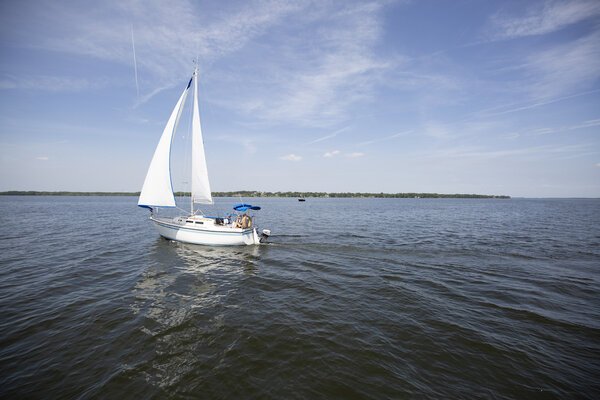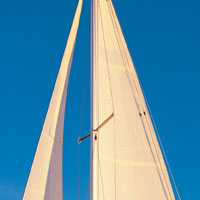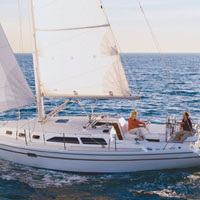If you’re learning how to sail—or if you’re thinking about purchasing a sailboat of your own—these handy terms can provide a helpful overview of sailing basics you need to become familiar with.
Explore Sailboat Brands & Manufacturers
10 Nautical and Sailing Terms Everyone Should Know
1. Aft
The back of a ship. If something is located aft, it is at the back of the sailboat. The aft is also known as the stern.
2. Bow
The front of the ship is called the bow. Knowing the location of the bow of the boat is important for defining two of the other most common sailing terms: port (left of the bow) and starboard side (right of the bow).
3. Port
Port is always the left-hand side of the boat when you are facing the bow. Because “right” and “left” can become confusing sailing terms when used out in the open waters, port defines the left side of the boat as it relates to the bow or front.
Read Next: Beginner Sailing Tips
4. Starboard
Starboard is always the right-hand side of the boat when you are facing the bow. Because “right” and “left” can become confusing sailing terms when used out in the open waters, starboard defines the right-hand side of the boat as it relates to the bow or front.
5. Leeward
Also known as lee, leeward is the opposite direction of the wind blowing (windward).
6. Windward
The direction in which the wind is currently blowing. Windward is the opposite of leeward (the opposite direction of the wind). Sailboats tend to move with the wind, making the windward direction an important sailing term to know.
7. Boom
The boom is the horizontal pole extending from the mast’s bottom. The sailboat can harness wind power to move forward or backward. This is done by adjusting the boom towards the direction of the wind.
8. Rudder
Located beneath the boat, the rudder is a flat piece of wood, fiberglass, or metal used to steer the boat. Larger sailboats control the rudder via a wheel, while smaller boats will have a steering mechanism directly aft.
9. Tacking
The opposite of jibing, this basic sailing maneuver refers to turning the boat’s bow through the wind so that the wind changes from one side of the boat to the other. The boom of a boat will constantly shift from one side to the other when performing a tack or a jibe.
10. Jibing
The opposite of tacking, this basic sailing maneuver refers to turning the stern of the boat through the wind so that the wind changes from one side of the boat to the other. The boom of a boat will always shift from one side to the other when performing a tack or a jibe. Jibing is a less common technique than tacking since it involves turning a boat directly into the wind.
Conclusion: Learn Nautical Terms Before Setting Sail!
In conclusion, knowing sailing terms and phrases is an essential skill for anyone who wants to take up sailing as a hobby. It enables sailors to communicate effectively with each other and understand the different parts of the boat and their functions. It also enhances safety and reduces the risk of accidents on the water.
Therefore, whether you are a seasoned sailor or a beginner, learning these sailing terms can enhance your enjoyment of this exciting and rewarding sport!
Editor’s Note: This article was updated in April 2023.



